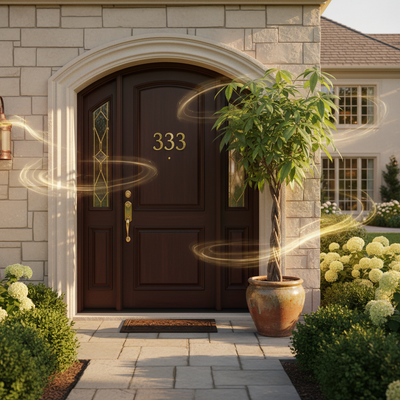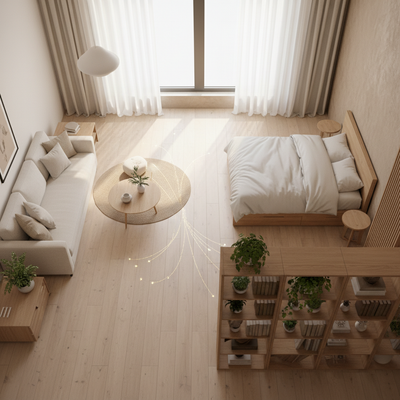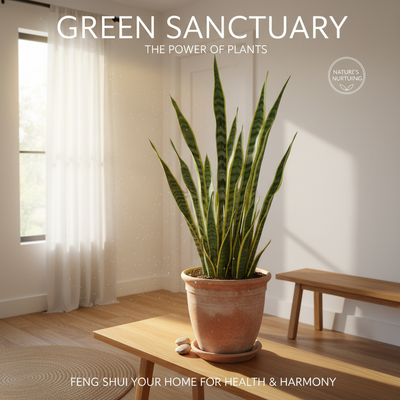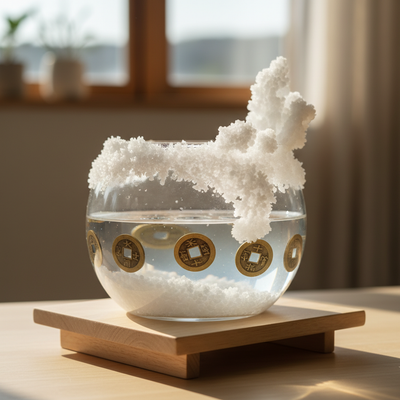A Place of Peace, Not Stress
This problem is common. You turn down the lights, get into bed, and wait for sleep to come. But instead, your thoughts keep racing. You think about what happened today, make lists of things to do tomorrow, and good sleep feels impossible to reach. We understand this problem, and we know that the answer often lies in the room where you try to rest. In Feng Shui, the old practice of living in harmony with our surroundings, we believe that everything is energy, or Qi. The energy in your bedroom greatly affects how well you can rest and feel refreshed.
Color is one of the strongest and easiest ways to change this energy. It's not just about making things look nice; it's about carefully creating a feeling that tells your body and mind it's time to relax. This guide will help you choose and use the best feng shui bedroom colors for sleep, turning your space into a real place of peace.
The 5 Best Color Groups
To directly answer what colors help you rest better, we have put together the five most helpful color groups from a Feng Shui point of view. These colors create the calm, Yin energy that's needed for a peaceful sleep space.
Earth Colors for Feeling Grounded
This group includes soft beiges, sandy browns, warm creams, and gentle orange-browns. These colors connect to the Earth element in Feng Shui. The Earth element is all about being stable, fed, and supported. When you surround yourself with these colors, you naturally tap into the feeling of being held and grounded. This sense of safety is basic for letting go of worry and falling into peaceful sleep. Think of how good warm sand feels under your feet; that's the energy these colors bring to your bedroom. They create a cozy, caring space that feels safe and steady.
Soft Blues for Calmness
When thinking about blue, choose soft, quiet shades like gentle sky blue, light powder blue, or calming blue-gray. These colors connect to the Water element. In Feng Shui, Water means peace, wisdom, and a gentle, downward flow of energy—perfect for winding down. Unlike bright, electric blues, these softer colors naturally calm your nervous system. They remind you of a still lake or clear sky, helping to quiet a busy mind. A bedroom painted in soft blue can feel like a gentle hug, washing away the day's stress and getting you ready for deep thought and rest.
Soft Greens for Fresh Starts
The best greens for a bedroom are those found in nature: sage green, pale mint, soft moss, and quiet olive. These shades connect to the Wood element, which means growth, life, and healing. The Wood element helps create a sense of renewal, making it a great choice for a space meant for physical and mental recovery. Surrounding yourself with soft greens can help release tension and create a feeling of fresh beginnings. It's like bringing the healing energy of a quiet forest into your room, letting you heal from the day's work and wake up feeling refreshed and renewed.
Gentle Pinks for Caring
Forget hot pink or bright magenta. For sleep, we use the softest colors: dusty rose, blush pink, and pale, peachy corals. These colors are a gentle form of the Fire element. While bright red is too exciting for a bedroom, these quiet pinks show the softest side of fire—warmth, gentle love, and partnership. They create a soothing, caring feeling that can be deeply comforting. This color group is especially good for building self-love and creating soft, romantic energy in a couple's bedroom, all without bringing in the disturbing Yang energy of brighter shades.
Calm Grays (Be Careful)
Gray can help you rest, but the exact shade matters a lot. We suggest very light, warm-toned grays, often called "greige" (a mix of gray and beige). These shades work as a quiet, neutral background, helping create stillness and rest. They belong to the Metal element, which is about clarity and precision, but in their softest form, they are simply neutral and undemanding. However, you must avoid dark, cold, or flat grays. These can create the energy of a cloudy, sunless day, possibly leading to feelings of sadness, tiredness, or being stuck if used too much.
Understanding Basic Ideas
Picking a color from a list helps, but understanding why certain colors work gives you power. Feng Shui color theory is based on two main ideas: Yin and Yang balance and the Five Elements.
Finding Yin-Yang Balance
In Feng Shui, all energy is a dance between two opposite but matching forces: Yin and Yang.
- Yang energy is active, bright, loud, and expanding. Think of a sunny day, loud music, or a busy office.
- Yin energy is passive, dark, soft, and quiet. Think of a moonlit night, a quiet library, or the stillness of a deep lake.
To help rest, the bedroom must be mostly a Yin space. This is where we go to retreat, recharge, and be still. The colors we choose are a main way to build this calming Yin energy. Soft, quiet, and deep colors are Yin, while bright, lively, and strong colors are Yang. The goal is to create a safe place of Yin energy that lets our own active Yang energy from the day calm down.
The Five Elements Plan
The Five Elements—Wood, Fire, Earth, Metal, and Water—are the building blocks of Feng Shui. Each element connects to specific colors, energies, and life areas. A balanced space has a good mix of these elements, chosen for the room's purpose. For the bedroom, we want to focus on the elements that help rest and care.
This table gives a simple plan for understanding their roles in a sleep sanctuary:
| Element | Colors | Energy / Emotion | Best for Bedroom? |
|---|---|---|---|
| Wood | Greens, Browns | Growth, Healing, Vitality | Yes (soft shades) |
| Fire | Reds, Bright Oranges, Pinks | Passion, Action, High Energy | In moderation (pinks) / Avoid (brights) |
| Earth | Beiges, Sandy Tones, Yellows | Grounding, Stability, Nourishment | Yes (soft shades) |
| Metal | Whites, Grays, Metallics | Clarity, Precision, Logic | In moderation (off-whites, light grays) |
| Water | Blues, Black | Calmness, Flow, Introspection | Yes (soft blues) / Avoid (black) |
As you can see, the most helpful colors for sleep match with the Earth, Wood, and Water elements, with gentle touches of Fire (pinks) and Metal (off-whites).
Using Colors in Your Room
Knowing which colors to use is the first step. The next is using them well. You don't need to cover your room in one single color. A balanced and smart approach often works best.
The 60-30-10 Rule
This is a classic interior design rule that works perfectly with Feng Shui. It makes sure you have a balanced and harmonious color scheme.
- 60% Main Color: This is the main color of your room, usually used on the walls. It sets the overall energy tone.
- 30% Second Color: This color supports the main one and adds interest. It's often found in bedding, curtains, or an accent wall.
- 10% Accent Color: This is used sparingly to add a final touch of energy. Think throw pillows, artwork, or small decor items.
For example, a restful feng shui bedroom colors for sleep might use this formula: 60% warm beige walls (Earth), 30% soft blue bedding and curtains (Water), and 10% accents from a sage green plant (Wood).
Start with Large Areas
The walls and ceiling have the biggest impact on the room's Qi because they surround you. Choosing a main color from our suggested groups (Earth, soft Blue, soft Green) for your walls is the most effective way to create a restful foundation. We always suggest testing paint samples directly on your walls. Watch how the color looks in the morning light, at midday, and with your evening lamps on. The light in your specific room will change how the color looks and feels.
Add Layers with Bedding and Rugs
If painting feels like too big a step, start with fabrics. Your bedding is what you are physically closest to during sleep, making its color and texture very important. Changing a busy or bright duvet cover for one in a solid, calming shade of sandy beige, soft green, or powder blue can make an immediate difference. A large area rug can also bring in a grounding Earth tone or a calming Water element to the space.
Finish with Thoughtful Accents
This is where you can use your "10%" accent color to fine-tune the room's energy. A pair of dusty rose pillowcases can add a touch of warmth and caring energy. A piece of art showing a peaceful forest can bring in the healing Wood element. The key is to be thoughtful. Each object should add to the overall feeling of calm and sanctuary, rather than creating visual noise or distraction.
Making It Personal with Your Kua
For a truly customized approach, we can go beyond general suggestions and look at your personal Feng Shui energy. This is done using your Kua number, which is calculated from your birth year and gender. It connects you to one of the Five Elements and tells you which energies are most nourishing for you personally.
Finding Your Kua Number
Your Kua number puts you into one of two groups: the East Group or the West Group. Each group has specific colors and elements that are especially supportive. While online calculators are available, a simple way to think about it is that each group thrives on a different set of elemental energies. Finding your specific number gives a personalized roadmap for your decor.
Colors for the East Group
People with a Kua number of 1, 3, 4, or 9 belong to the East Group. This group naturally connects to the Wood and Water elements.
- Your Nourishing Colors: These are colors from your own and your supporting elements. For you, this means the colors of the Water element (blues, soft black) and the Wood element (greens). These colors will make you feel most at home and refreshed. A bedroom with a base of soft green or blue is ideal.
- Your Supporting Colors: To add a touch of warmth and life, you can use colors from the Fire element (pinks, soft corals) as accents. In the cycle of elements, Wood feeds Fire, so this element complements your energy.
Colors for the West Group
People with a Kua number of 2, 5, 6, 7, or 8 belong to the West Group. This group mainly aligns with the Earth and Metal elements.
- Your Nourishing Colors: You will feel most stable and rested when surrounded by the colors of the Earth element (beiges, sandy tones, soft yellows) and the Metal element (off-whites, light grays, metallics). A bedroom grounded in these tones will feel deeply supportive.
- Your Supporting Colors: The Fire element supports you because, in the elemental cycle, Fire creates Earth (ash). Therefore, using gentle pinks or warm, peachy tones as your accent colors can add a wonderful layer of caring energy.
Bedroom Colors to Avoid
Just as important as knowing what colors to use is knowing which ones to avoid in a sleep sanctuary. Certain colors bring in a disruptive, high-energy Yang quality that is the opposite of rest.
High-Energy Yang Colors
Bright red, strong orange, and bold, sunny yellow should be avoided in large amounts in the bedroom. These are the colors of the Fire element in its most active state. They connect to excitement, action, and high-energy conversation. While a tiny accent might be okay if balanced carefully, using them on walls or in bedding can create an environment that feels disturbing and can contribute to an overactive mind, making it hard to fall asleep.
Sharp and Heavy Colors
A purely brilliant white room might seem clean and simple, but in Feng Shui, it can feel sterile and clinical. Stark white is a color of the Metal element, which connects to logic and precision. Too much of it can keep your mind "switched on" and lack the warmth and softness needed for true relaxation. Similarly, using large amounts of black or dark, heavy gray can be problematic. These colors connect to the Water element, but in their deepest form, they can feel oppressive, heavy, and lead to feelings of sadness, depression, or energetic stagnation if they take over the space.
A Real-World Change
Theory is one thing, but seeing it in practice is another. At THE QI FLOW, we worked with a client who perfectly shows the power of these principles.
The Client's Problem
Our client, "Sarah," was a successful graphic designer living in a stylish, modern apartment. She came to us complaining of chronic insomnia and an inability to "shut off" her brain at night. Her bedroom was decorated in a scheme she'd seen in a magazine: brilliant white walls, a black metal bed frame, and a single, large piece of abstract art in a bright yellow. She loved the look, but she wasn't sleeping.
Our Feng Shui Analysis
The THE QI FLOW team immediately identified a severe elemental imbalance. The room was dominated by the Metal element (brilliant white, metal frame), which promotes mental sharpness, logic, and alertness—great for an office, but terrible for a bedroom. The bright yellow art piece was a jarring burst of the Fire element, acting like an alarm clock in a space meant for rest. Critically, there were no grounding Earth elements to provide stability or calming Water elements to encourage peace. Her bedroom was energetically "wired" for work and creative brainstorming, not sleep.
The Solution We Used
We proposed a transformation that didn't require a complete overhaul. Our recommendations were targeted and strategic:
1. We advised repainting the wall behind her bed a deep, soft sage green. This brought in the healing and renewing energy of the Wood element, creating a focal point of calm.
2. We had her switch her stark white duvet for one in a warm, sandy beige. This immediately brought in the grounding, nurturing energy of the Earth element.
3. We introduced a few throw pillows in a quiet, dusty blue and suggested she replace the yellow art with a piece showing a peaceful seascape. This layered in the serene, calming energy of the Water element.
The Good Result
The change was amazing. Within two weeks, Sarah reported that walking into her bedroom felt "like an exhale." The space felt softer, warmer, and deeply calming. She told us her mind felt less busy and cluttered at bedtime, and for the first time in months, she was falling asleep easily and sleeping through the night. It was a powerful example of how a few thoughtful color shifts can completely change a room's energy and function.
More Feng Shui Sleep Tips
Color is a cornerstone, but it works best as part of a complete approach. Here are three more quick tips to enhance your sleep sanctuary.
1. The Command Position
Position your bed so that you have a clear view of the bedroom door while lying down, but are not directly in line with it. This creates a subconscious sense of security and control, allowing you to fully relax.
2. Declutter and Simplify
Clutter creates stagnant energy (Sha Qi) and visual distraction. Keep surfaces, especially your nightstands, clear of anything that isn't essential for rest. Store items neatly under the bed or in a closet to maintain a peaceful, open flow of energy.
3. Soften the Lighting
Harsh, overhead lighting is jarringly Yang. In the hours before bed, switch to soft, warm light from lamps. Use low-wattage, warm-toned bulbs to create a gentle, calming atmosphere that signals to your body that it's time to wind down.
Creating Your Sanctuary
Your bedroom is the most personal room in your home. It should be a space that nurtures you, heals you, and prepares you for the day ahead. By understanding the power of Yin energy, balancing the Five Elements through color, and personalizing your palette, you can move beyond simply decorating. You can begin to thoughtfully craft a sanctuary. We encourage you to experiment with these feng shui bedroom colors for sleep, trust your intuition, and notice how these changes feel. A bedroom that truly supports deep, restful sleep is not a luxury; it is a foundation for a healthy and vibrant life.







